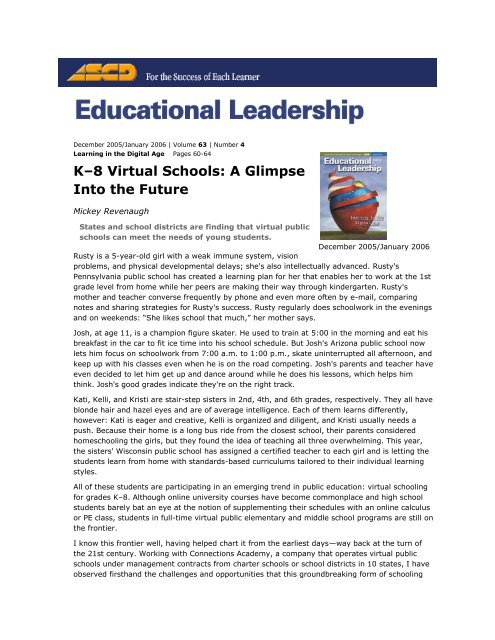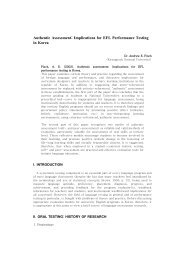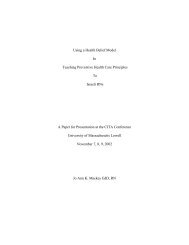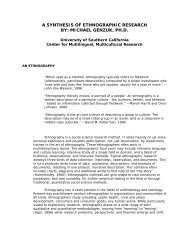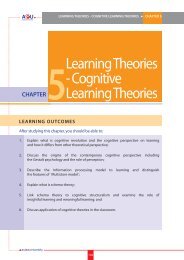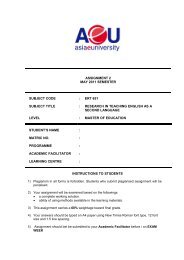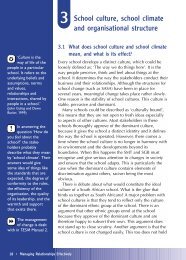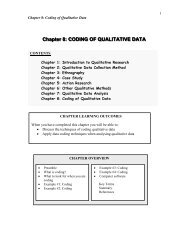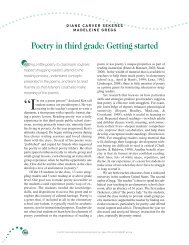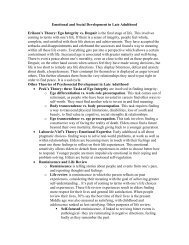Kâ8 Virtual Schools: A Glimpse Into the Future - learningdomain
Kâ8 Virtual Schools: A Glimpse Into the Future - learningdomain
Kâ8 Virtual Schools: A Glimpse Into the Future - learningdomain
You also want an ePaper? Increase the reach of your titles
YUMPU automatically turns print PDFs into web optimized ePapers that Google loves.
December 2005/January 2006 | Volume 63 | Number 4Learning in <strong>the</strong> Digital Age Pages 60-64K–8 <strong>Virtual</strong> <strong>Schools</strong>: A <strong>Glimpse</strong><strong>Into</strong> <strong>the</strong> <strong>Future</strong>Mickey RevenaughStates and school districts are finding that virtual publicschools can meet <strong>the</strong> needs of young students.December 2005/January 2006Rusty is a 5-year-old girl with a weak immune system, visionproblems, and physical developmental delays; she's also intellectually advanced. Rusty'sPennsylvania public school has created a learning plan for her that enables her to work at <strong>the</strong> 1stgrade level from home while her peers are making <strong>the</strong>ir way through kindergarten. Rusty'smo<strong>the</strong>r and teacher converse frequently by phone and even more often by e-mail, comparingnotes and sharing strategies for Rusty's success. Rusty regularly does schoolwork in <strong>the</strong> eveningsand on weekends: ―She likes school that much,‖ her mo<strong>the</strong>r says.Josh, at age 11, is a champion figure skater. He used to train at 5:00 in <strong>the</strong> morning and eat hisbreakfast in <strong>the</strong> car to fit ice time into his school schedule. But Josh's Arizona public school nowlets him focus on schoolwork from 7:00 a.m. to 1:00 p.m., skate uninterrupted all afternoon, andkeep up with his classes even when he is on <strong>the</strong> road competing. Josh's parents and teacher haveeven decided to let him get up and dance around while he does his lessons, which helps himthink. Josh's good grades indicate <strong>the</strong>y're on <strong>the</strong> right track.Kati, Kelli, and Kristi are stair-step sisters in 2nd, 4th, and 6th grades, respectively. They all haveblonde hair and hazel eyes and are of average intelligence. Each of <strong>the</strong>m learns differently,however: Kati is eager and creative, Kelli is organized and diligent, and Kristi usually needs apush. Because <strong>the</strong>ir home is a long bus ride from <strong>the</strong> closest school, <strong>the</strong>ir parents consideredhomeschooling <strong>the</strong> girls, but <strong>the</strong>y found <strong>the</strong> idea of teaching all three overwhelming. This year,<strong>the</strong> sisters' Wisconsin public school has assigned a certified teacher to each girl and is letting <strong>the</strong>students learn from home with standards-based curriculums tailored to <strong>the</strong>ir individual learningstyles.All of <strong>the</strong>se students are participating in an emerging trend in public education: virtual schoolingfor grades K–8. Although online university courses have become commonplace and high schoolstudents barely bat an eye at <strong>the</strong> notion of supplementing <strong>the</strong>ir schedules with an online calculusor PE class, students in full-time virtual public elementary and middle school programs are still on<strong>the</strong> frontier.I know this frontier well, having helped chart it from <strong>the</strong> earliest days—way back at <strong>the</strong> turn of<strong>the</strong> 21st century. Working with Connections Academy, a company that operates virtual publicschools under management contracts from charter schools or school districts in 10 states, I haveobserved firsthand <strong>the</strong> challenges and opportunities that this groundbreaking form of schooling
presents for U.S. education.Public <strong>Schools</strong> Without <strong>the</strong> BricksFor many people, <strong>the</strong> term virtual school conjures up visions of a computer-centric program inwhich students receive <strong>the</strong>ir entire curriculum through <strong>the</strong> Internet. Indeed, some of today'svirtual schools offer this model. But more often, schools serving younger learners provide amixture of online and offline activities, with print textbooks and hands-on materials playing a roleequal to that of digital technology. In such schools, <strong>the</strong> computer functions as a management toolthat enables personalization of <strong>the</strong> program for individual learners and real-time collection anduse of student achievement data for deep accountability.What makes <strong>the</strong>se varied schools virtual is <strong>the</strong> fact that <strong>the</strong> student and <strong>the</strong> teacher work indifferent locations. What makes <strong>the</strong>m public is <strong>the</strong> set of defining characteristics <strong>the</strong>y share with<strong>the</strong>ir brick-and-mortar counterparts. <strong>Virtual</strong> public schools must serve all students who choose toenroll and who are eligible within state guidelines, without regard to ability, previous schoolperformance, or family circumstance. They are available to families at no cost. Like traditionalschools, virtual public schools use standards-aligned curriculums, employ certified teachers, andrequire students to take proctored state standardized tests, often with o<strong>the</strong>r students at localschool facilities.As <strong>the</strong>y do in traditional public schools, professional teachers play a central role in K–8 virtualschools, which must meet <strong>the</strong> same NCLB-defined standards for ―highly qualified‖ teaching staffas any o<strong>the</strong>r U.S. public school. That means having <strong>the</strong> necessary grade-level certifications, aswell as subject-area credentials in <strong>the</strong> upper grades. In virtual middle schools, a student mayhave separate teachers for math, social studies, science, and language arts as well as a―homeroom‖ teacher who is <strong>the</strong> primary point of contact for <strong>the</strong> family. Homeroom andelementary virtual-school teachers typically have student loads of 40–50 students, but <strong>the</strong>irinteractions with students are always one-on-one.In all K–8 virtual public school programs, a responsible adult, or learning coach, works with <strong>the</strong>certified teacher to implement <strong>the</strong> student's learning program. Often this learning coach is <strong>the</strong>student's parent, but grandparents, aunts and uncles, caregivers, and o<strong>the</strong>rs can also performthis role. Although <strong>the</strong> teacher creates and grades assignments, modifies lesson plans to meetindividual student needs, and determines whe<strong>the</strong>r <strong>the</strong> student is ready to advance to <strong>the</strong> nextunit or grade, <strong>the</strong> learning coach serves as <strong>the</strong> student's face-to-face motivator and as <strong>the</strong> eyesand ears of <strong>the</strong> school. The learning coach can observe firsthand all <strong>the</strong> student's interactionswith <strong>the</strong> teacher through e-mail, phone, message board, and mail and has regular conferenceswith <strong>the</strong> teacher throughout <strong>the</strong> year. Teachers new to K–8 virtual schools often remark that <strong>the</strong>irclose partnership with families is an unexpected benefit of <strong>the</strong>ir new working environment.Families choose virtual schooling for a wide variety of reasons. Some students are significantlyahead of or behind <strong>the</strong>ir peers; o<strong>the</strong>rs have learning disabilities or physical health issues. Somestudents were ―bully magnets‖ at <strong>the</strong>ir traditional schools; o<strong>the</strong>rs were <strong>the</strong> bullies. Families inisolated rural areas may turn to virtual schools because of transportation issues, whereas familiesin core urban areas may go virtual out of concern for <strong>the</strong>ir children's safety. Young actors,athletes, and musicians may choose a virtual school for <strong>the</strong> scheduling flexibility it offers.Students who simply need more personal attention in <strong>the</strong>ir education program often find virtualschools a good fit.<strong>Virtual</strong> schooling customizes <strong>the</strong> school program to meet each student's particular learning needs.Thus, an example of a ―typical day‖ at a virtual school can be ra<strong>the</strong>r elusive. One student mayconcentrate on a single subject for multiple hours, whereas ano<strong>the</strong>r may change topics frequentlyand take plenty of breaks. Many students work during typical school hours—Monday through
Friday, early morning through afternoon; o<strong>the</strong>rs find <strong>the</strong>mselves more productive at night or onweekends. Some learning coaches and students talk to <strong>the</strong>ir teachers on <strong>the</strong> phone several timesa day; o<strong>the</strong>rs communicate purely by e-mail between scheduled phone conferences. ―No SuchThing as a Typical Day‖ suggests <strong>the</strong> different kinds of schedules that virtual-school students mayfollow.No Such Thing as a Typical DayEmily, Grade 4Emily starts virtual school at 8:00 a.m. sharp every weekday with an hour ofreading/language arts followed by an hour of math. From 10:00 to 11:00, shestudies science or state history on alternating days, followed by PE (which couldbe a bike ride with her dad, who is also her learning coach, or dancing for half anhour to her favorite songs, all logged and reported to her teacher).After lunch, Emily works on music or art. She ends <strong>the</strong> day by 1:30 with a halfhourof e-mailing to classmates and posting to <strong>the</strong> school message boards. Herafternoons are free for her scrap-booking hobby, scout troop meetings, avolunteer visitor gig at <strong>the</strong> local nursing home, or—best of all, in her opinion—reading <strong>the</strong> latest chapter book suggested by her teacher for extra credit.Zack, Grade 8Zack has never been a morning person, so his virtual-school days—which includeSaturdays—rarely start before 10:00 a.m. As Zack's learning coach, his mo<strong>the</strong>ruses <strong>the</strong> early morning weekday hours to take care of such school managementtasks as logging <strong>the</strong> previous day's activities, reviewing Zack's assessment scores,and talking on <strong>the</strong> phone with Zack's teacher. Once Zack gets rolling, he follows<strong>the</strong> virtual-school version of block scheduling, with two-hour-plus stints ofintensive work on two subjects a day, followed by an hour on an elective, such asSpanish or technology literacy, depending on <strong>the</strong> day. Friday is a short day,usually just one late-morning math class—but Saturdays are devoted to sciencebecause Zack spends his weekends with his fa<strong>the</strong>r, who happens to be anengineer and shares custody with Zack's mom.What About Socialization and Diversity?Some educators worry that virtual schooling will isolate students, sequestering <strong>the</strong>m with <strong>the</strong>irhome computers and cutting <strong>the</strong>m off from interaction with <strong>the</strong>ir peers and <strong>the</strong> outside world.High-quality virtual K–8 schools typically address this concern by arranging for frequent schoolfield trips and social activities among families who live near one ano<strong>the</strong>r. School personnel shouldalso encourage families to continue or expand <strong>the</strong>ir children's existing community-basedactivities—from scouting to youth sports to volunteer programs. For example, by joining a localsoccer league, students may receive PE credit for soccer practice and games.But virtual schools also create communities of a different kind: online communities in whichstudents unite and interact because of common interests ra<strong>the</strong>r than mere geography. Statewide
online chess clubs, school newspapers, and Quiz Bowls thrive in virtual schools. Students-onlymessage boards sprout threads about everything from horses to Harry Potter, with posts from allover <strong>the</strong> United States.Statistics show that virtual schools attract a cross section of students in terms of ethnicity, homelanguage, socioeconomic status, and special needs. In Connections Academy schools, forexample, more than 40 percent of students qualify for free or reduced-price lunch; 20 percent areminorities; 15 percent are special-needs students with individualized education plans; 39 percentlive in rural areas; and 14 percent live in <strong>the</strong> inner city. This diversity creates opportunities tobroaden <strong>the</strong> perspectives of virtual-school students. Young people whose paths might never crossin <strong>the</strong> traditional school system—for example, <strong>the</strong> farm boy from southwestern Pennsylvania and<strong>the</strong> streetwise kid from inner-city Philly—may collaborate on school projects and become onlinefriends.The <strong>Virtual</strong> Learning EvolutionIn <strong>the</strong> current school year, full-time virtual schools are among <strong>the</strong> public school options forgrades K–8 in a dozen U.S. states. 1 At least 10 states allow statewide virtual charter schools,which enroll hundreds or even thousands of students and may contract with such providers asConnections Academy for curriculum and technology services; Ohio and Pennsylvania have someof <strong>the</strong> largest of <strong>the</strong>se ―cyber charters.‖ Florida is in its third year of a statewide K–8 virtual pilotprogram administered directly by <strong>the</strong> state department of education. In o<strong>the</strong>r states, such asColorado, school districts that develop virtual schools on <strong>the</strong>ir own or with <strong>the</strong> help of acurriculum provider can enroll students statewide.The total number of virtual schools in <strong>the</strong> United States is estimated at about 200, up from fewerthan a dozen in <strong>the</strong> 2000–2001 school year. The number is continually growing as states amend<strong>the</strong>ir charter school laws to allow virtual charter schools (as Indiana did this year) and open updistrict-run virtual schools to students across <strong>the</strong> state (as Washington State has been doing thisfall). Individual school districts are also launching small cyber-schools to serve <strong>the</strong>ir ownstudents, a move that typically does not require state approval.In a report issued in fall 2004, Distance Education Courses for Public Elementary and SecondarySchool Students, <strong>the</strong> National Center for Education Statistics (NCES) estimated that 36 percent ofall school districts in <strong>the</strong> United States had students participating in virtual learning of some kindand that a total of 325,000 students were enrolled in online learning courses and virtual schools.Given that <strong>the</strong> study focused on data from <strong>the</strong> 2002–2003 school year, <strong>the</strong>se numbers havecertainly grown.The footprint of K–8 virtual learning in this larger field is still small, however. According to <strong>the</strong>NCES study, only 3 percent of <strong>the</strong> enrollments in distance learning courses were by students inelementary and middle school, compared with 68 percent in high school. (The remaining 29percent are from combined K–12 or ungraded schools.)As virtual learning evolves, states with significant concentrations of full-time virtual schoolsstruggle to ensure quality and accountability. For example,In Ohio this year, lawmakers instituted additional testing requirements for all charterschools but added extra teeth to laws for ―e-schools,‖ cutting off funding for students in<strong>the</strong>se schools who fail to make expected gains for multiple years.Pennsylvania and Idaho created new state-level approval regulations for statewide virtualcharter schools, eliminating <strong>the</strong> ability of individual districts to create charter schools toserve o<strong>the</strong>r districts' students.
California has created strict budgetary requirements for virtual charter schools,mandating <strong>the</strong> percentage of per-pupil funds that must be spent on instructional services,teacher salaries, and so on.Arizona capped increases in <strong>the</strong> number of students enrolled at 100 percent annually foreach individual virtual public school, although it loosened its requirement that all virtualschoolstudents must have attended public school <strong>the</strong> previous year. This requirementhad blocked homeschoolers and private school students from switching to virtual schools.Techno-ByteSeventy-seven percent of U.S. children ages 7–17 lived in households withpersonal computers in 2003, up from 36 percent in 1994.—Children's Partnership, 2005Illuminating <strong>the</strong> <strong>Future</strong>Even <strong>the</strong> most passionate advocates of virtual schooling readily admit that only a small portion of<strong>the</strong> K–8 student population will ever partake in this mode of education. Never<strong>the</strong>less, <strong>the</strong>challenges facing full-time K–8 virtual schooling shed light on some core education issues in <strong>the</strong>21st century.Individualization. Theoretically, each student in a virtual school can have a personalized learningexperience that incorporates a unique schedule and curricular mix. If virtual schools can provethat such individualization improves learning, <strong>the</strong>ir example could have a profound impact ontraditional classrooms, with <strong>the</strong>ir ever-increasing computer-to-student ratios. Someday, <strong>the</strong>secomputers might be harnessed by <strong>the</strong> regular classroom teacher to truly differentiate instructionaccording to each student's needs—for example, by offering five varieties of fast-paced ma<strong>the</strong>xercises and ano<strong>the</strong>r five flavors of step-by-step math tutoring, plus 15 variations on <strong>the</strong> ―main‖math activity for <strong>the</strong> rest of <strong>the</strong> class, with careful data capture on each student's performance.Funding. Statewide virtual public schools are currently funded in many different ways. Some of<strong>the</strong>se include full per-pupil funding that follows <strong>the</strong> student from a brick-and-mortar school to avirtual charter, as in Pennsylvania; fees paid per course by <strong>the</strong> student's resident district to <strong>the</strong>district providing <strong>the</strong> virtual courses, up to a maximum number of courses equaling a full schoolprogram, as in Minnesota; or a special flat ―virtual-school rate‖ paid directly by <strong>the</strong> state, as inFlorida. All <strong>the</strong>se funding approaches raise <strong>the</strong> same question: What should a good education costwhen students throughout a state—from <strong>the</strong> smallest rural community to <strong>the</strong> toughest urbanneighborhood to suburbs of all kinds—enroll in <strong>the</strong> same school? Meanwhile, advocates of highqualityvirtual schooling caution policymakers that virtual learning isn't a bargain route: Goodtechnology, curriculum, and accountability systems require significant investment.Teaching. <strong>Virtual</strong>-school teachers create assignments, assess student work, modify <strong>the</strong>curriculum for individual learners, and even provide direct instruction to students individually orin small groups, but <strong>the</strong>y rarely see <strong>the</strong>ir students face-to-face, and <strong>the</strong>y can't look over <strong>the</strong>irstudents' shoulders as <strong>the</strong>y work. Does this diminish <strong>the</strong>ir role as teachers—or actually focus<strong>the</strong>m on <strong>the</strong> most essential teaching tasks? In regular classrooms as well, although most teachers
will maintain face-to-face interaction with <strong>the</strong>ir students, technology may allow a refinement of<strong>the</strong> teachers' core duties. The experiences of those involved in professional development coursesspecifically for virtual-school teachers—which are springing up at Boise State University, <strong>the</strong>University of Maryland, and o<strong>the</strong>r institutions—should help shed light on <strong>the</strong> evolving role ofteachers.During <strong>the</strong> next decade, as technology enables learning to happen anytime and anywhere, asschools struggle to bring out <strong>the</strong> best in learners with vastly different backgrounds and abilities,and as parents demand more choices, virtual schools will continue to push <strong>the</strong> envelope on issuesof concern to all schools. As Susan Patrick, former technology chief at <strong>the</strong> U.S. Department ofEducation and current CEO of <strong>the</strong> North American Council for Online Learning, puts it, ―Full-timevirtual schools show us <strong>the</strong> future.‖Endnote1 States that offer full-time K–8 virtual schooling are Alaska, Arizona, Arkansas, California, Colorado, Florida, Idaho,Minnesota, Ohio, Oregon, Pennsylvania, and Wisconsin.Mickey Revenaugh is Vice President for Partnerships and Outreach at Connections Academy, a provider of servicesfor virtual public schools; 718-294-4495; mrevenaugh@earthlink.net; www.connectionsacademy.com.Copyright © 2005 by Association for Supervision and Curriculum Development© Copyright ASCD. All rights reserved.


